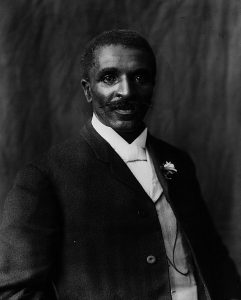16 George Washington Carver
George Washington Carver |
|
Time period: 1864-January 5th, 1943Subject: Agricultural science, chemistry |
|
Biography:George Washington Carver was born enslaved in Missouri and orphaned as an infant during the Civil War. He developed an interest in plants and collecting specimens on the farm. With the abolition of slavery, he supported himself through different occupations and acquired education through books and experience. After receiving a high school diploma in his twenties, he was rejected by many colleges due to racism. Carver initially studied art and piano and was encouraged by his professor to pursue a bachelor’s and a master’s degree in agricultural science at Iowa State University. He was the first African American to earn a Bachelor of Science degree. After graduation, he worked as a teacher and researcher at Tuskegee University. Carver served as the director of agricultural research in 1896. He was devoted to helping Southern agriculture, improving their economic situation, and promoting racial harmony. During that time, he development agricultural strategies to prevent soil depletion. Carver was considered an early environmentalism leader and received many honours for his research, including the Spingarn Medal of the NAACP. |
|
Summary of their contributions:Carver was the first black man to receive a bachelor’s degree in Science in the United States of America. He discovered by rotating crops (alternating the growing of cotton, legumes, and sweet potatoes, farmers can increase their yield. To improve the lives of farmers and enlarge the commercial possibilities of alternative crops, Carver developed 300 derivative products from peanuts and sweet potatoes. His work helped liberate the South from its dependence on cotton. George Washington Carver National Monument, the first monument dedicated to an African American and an individual who was not a president, was constructed. |
|
Integration with the BC Secondary Science Curriculum:In Environmental Science 11, the main content objective is to teach about energy flow through ecosystems and human actions and their impact on ecosystem integrity. Carver’s research on using alternative crops to prevent soil depletion can be introduced. As students should learn about land use and degradation and environmental ethics, policy, and laws in Environmental Science 12, Carver’s sustainable planting strategies and the associated political and social pushbacks can be incorporated. Also, because considering the role of scientists in innovation is a curricular competency student needs to develop, Carver’s work can be taught in junior science classes. |
|
References:https://www.nps.gov/teachers/classrooms/george-washington-carver-an-original-conservationist-lesson-one.htm https://www.history.com/topics/black-history/george-washington-carver https://www.britannica.com/biography/George-Washington-Carver https://www.smithsonianmag.com/history/search-george-washington-carvers-true-legacy-180971538/ |
|

